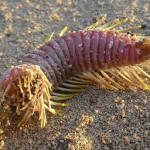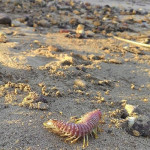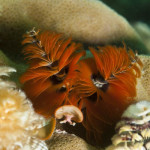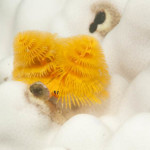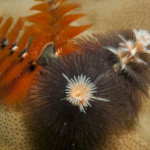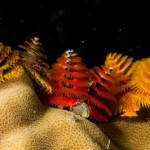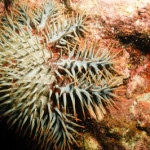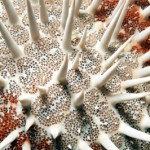Giant Centipede (Scolapendra subspinipes)
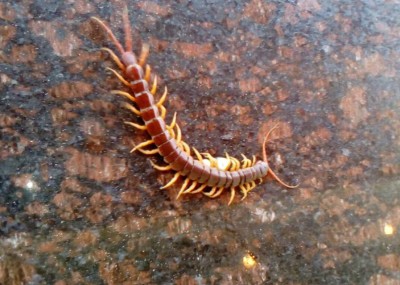
Image Copyright Teerasak Thomas Suamcheepmasau
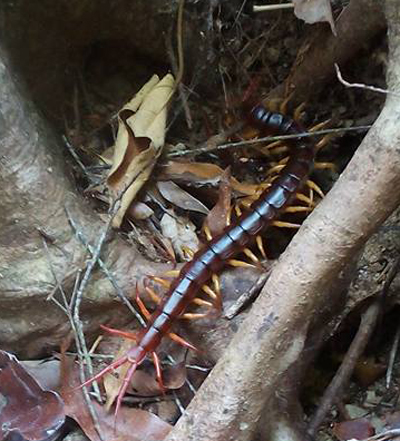
Image Copyright Sukanya Darasawang
Last Observed: January 2016, Koh Chang
Observed By: Teerasak Thomas Suamcheepmasau, Sukanya Darasawang
You have to draw the line somewhere. You can go as far as you like with the wonders of nature argument but at some stage you just have to step back and say that the Giant Centipede is a real nasty piece of work. Admire them if you must but make sure you do it at a distance for this is an extremely aggressive, fast-moving, highly poisonous predator. They eat whatever they can kill, and that’s a lot.
They are one of the world’s largest species of centipede and grow up to 20cm in length (I’m sure I’ve seen bigger on Koh Chang though).
Centipedes have only one pair of legs per segment whilst millipedes have four. This means that they can move far quicker.
They attack using a pair of modified legs on their head called forcipules that connect to venom glands.
Their poison is extremely painful but rarely fatal to humans.
You are most likely to encounter them in leaf litter or rotten wood – a compelling argument for avoiding gardening.
Giant Centipede Wikipedia
Asian Leaf Turtle (Cyclemis dentata)
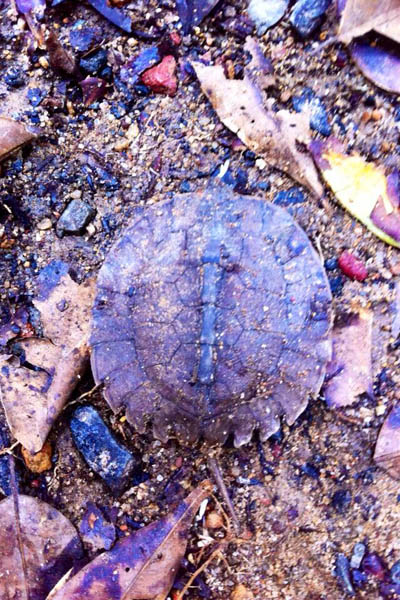
Image Copyright Nattapol Phutong
Last Observed: January 2016, Koh Chang
Observed By: Nattapol Phutong
The Asian leaf turtle is a Southeast Asian native species of turtle that is very common in the pet trade. It grows up to a maximum of 24cm in length.
Nature has some interesting defense mchanisms but the Asian leaf turtle’s is a strange one. When threatened it can squirt the contents of its digestive system. Puking on predators! Once again nature excels itself.
Asian Leaf Turtle Wikipedia
Blanford’s Bridle Snake (Dryocalamus davisonii)
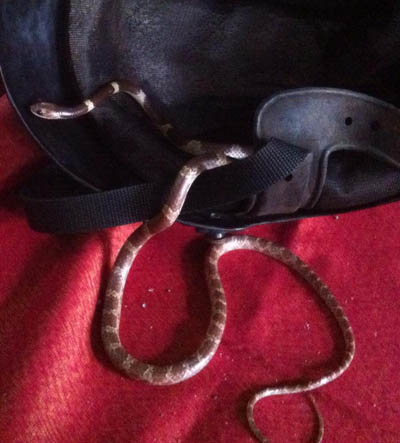
Image Copyright Heli pohjolainen
Last Observed: March 2016
Observed By: Heli Pohjolainen
Blanford’s Bridle Snake (a.k.a. the Indian Wolf Snake) is a small, non-venomous colubrid snake species that is endemic to Asia.
It is called a bridle snake due to it’s supposed resemblance to a horse’s bridle. You have to wonder if Davison, or Blanford, or whoever it was that named it had been in the jungle too long when they made that comparison.
Blanford’s Bridle Snake Wikipedia
Bearded Fireworm (Hermodice carunculata)
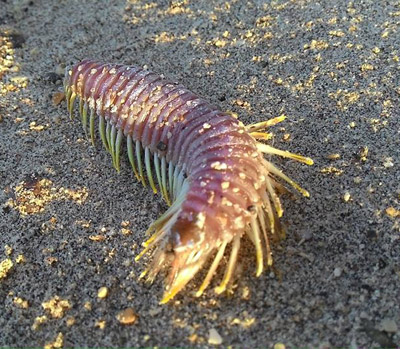
Image Copyright Teerasak Thomas Suamcheepmasau
Observed: Koh Chang, December 2015
Observed By: Teerasak Thomas Suamcheepmasau
The bearded fireworm is a strange marine creature that looks like a centipede on first glance (especially when seen on land like this specimen).
You will usually see them underwater, they are actually a tyle of marine bristleworm growing up to a maximum of 30cm in length.
The creature moves slowly but you should take great care not to accidentally touch it since its bristles contain a powerful neurotoxin that causes burning and intense irrtation as well as occasionally nausea and vomiting.
Bearded Fireworm Wikipedia
Image Copyright Teerasak Thomas Suamcheepmasau
Image Copyright Teerasak Thomas Suamcheepmasau
Barrel Sponge (Xestospongia testudinaria)
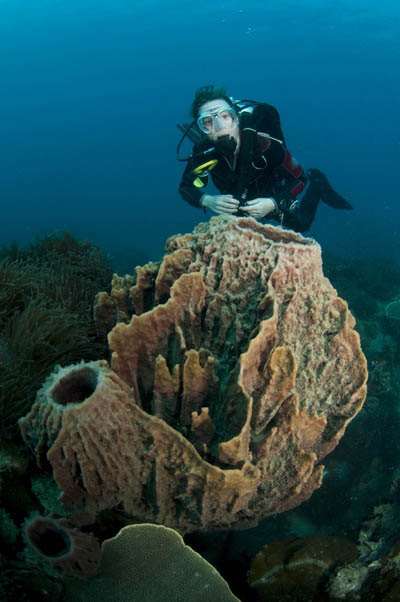
Image Copyright Jonathan Milnes
Observed: Koh Chang Reefs, October 2015
Observed By: Jonathan Milnes
Xestospongia testudinaria is a species of barrel sponge in the family Petrosiidae. It very closely resembles the giant barrel sponge (after all it is really large and looks like a kind of spongy barrel) but that species is only found in the caribbean sea.
Barrel Sponge Wikipedia
Christmas Tree Worm (Spirobranchus giganteus)
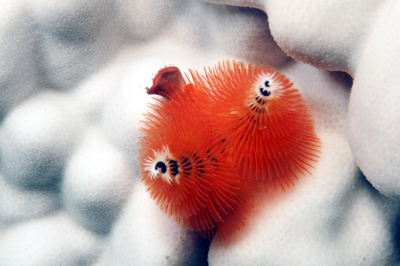
Observed: Koh Chang Reefs, December 2015
Observed By: Jonathan Milnes
The brightly-coloured spiral-bodied christmas tree worm is a type of tube-building polchaete worm.
These worms live inside rocky tubes that they build withing coral structures. They emerge from these tubes to feed, gathering in microorganisms using their tree-like array. When threatened though they whip rapidly back into their rocky home and disappear in a flash. A fun sight for divers and snorkellers.
Christmas Tree Worm Wikipedia
Image Copyright Jonathan Milnes
Image Copyright Jonathan Milnes
Image Copyright Jonathan Milnes
Image Copyright Jonathan Milnes
Crown-of-thorns Starfish (Acanthaster planci)
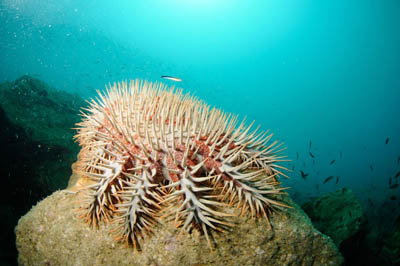
Image Copyright Jonathan Milnes
Observed: Koh Chang Reefs, December 2015
Observed By: Jonathan Milnes
The Crown-of-thorns starfish is a large 25-25cm wide starfish that is a voracious predator that feeds on corals.
It is named after the biblical crown of thorns since that is what its poisonous thorn-like spines resemble.
The crown-of-thorns has a few natural predators (although some species of triggerfish and snails feed on them) and so populations can grow to such high numbers that they can totally destroy coral reefs. So large numbers of crown-of-thorns seastar are a very bad thing for a coral reef and it is not uncommon for people to take action to control their numbers thus protecting the reef itself.
Crown-of-thorns Starfish Wikipedia
Image Copyright Jonathan Milnes
Image Copyright Jonathan Milnes
Black Sea Urchin (Diadema antillarum)
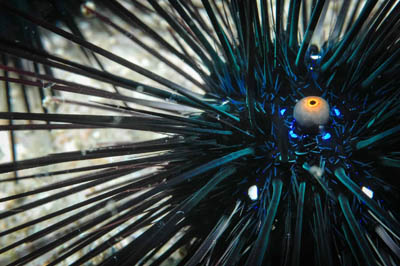
Image Copyright Jonathan Milnes
Observed: Koh Chang Reefs, December 2015
Observed By: Jonathan Milnes
Watch out for the sharp and brittle spines of the black sea urchin. A trailing hand or foot that brushes against them will cause them to break off in the flesh and despite having no poison they can easily cause infection and are the very devil to remove.
The black sea urchin, as you’d imagine has a black-coloured body and spines. It is massively widespread and is the most abundant herbivore on the coral reefs of Koh Chang.
Black Sea Urchin Wikipedia
Banded Sea Urchin (Echinotrix calamaris)
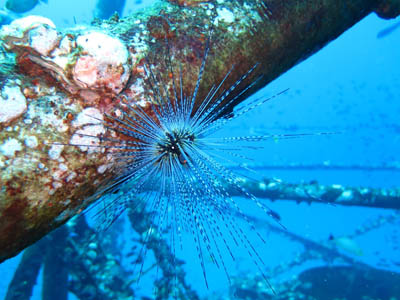
Image Copyright BB Divers
Observed: Koh Chang Reefs, December 2015
Observed By: BB Divers
Watch out for the sharp and brittle spines of the banded sea urchin. A trailing hand or foot that brushes against them will cause them to break off in the flesh and despite having no poison they can easily cause infection and are the very devil to remove.
The spines of the sea urchin radiate from a roundish shell that forms their endoskeleton and protects the urchin from predators. Like their close relatives the startfish sea urchins exhibit five fold symmetry with five equal-sized body parts radiating out from a central point.
Banded Sea Urchin Wikipedia
Murex Shell (Jorunna fenebris)
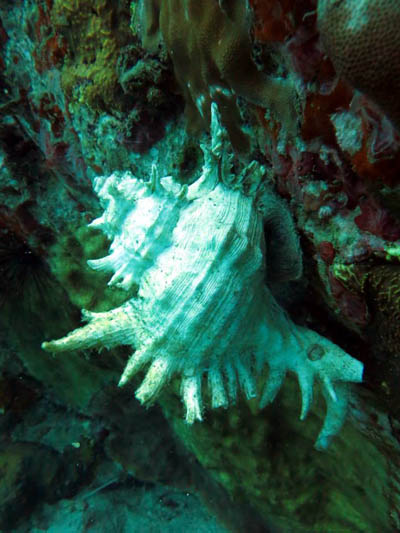
Image Copyright BB Divers
Observed: Koh Chang, December 2015
Observed By: BB Divers
The Muricidae are a family of sea snails that have charecteristic shells with elaborate protective spines protruding from them.
The majority of this family are carnivores that feed on smaller species of shells which they gain access to by boring through the shells and sucking out the soft contents (pause for a shudder!)
Muricidae Wikipedia






